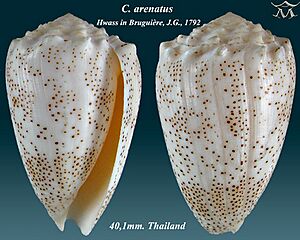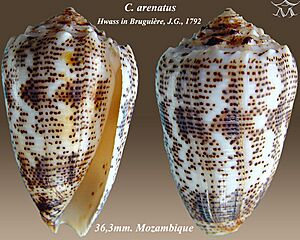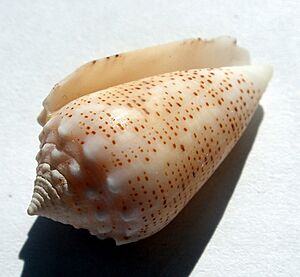Conus arenatus facts for kids
Quick facts for kids Conus arenatus |
|
|---|---|
 |
|
| Front and back views of the shell of Conus arenatus | |
 |
|
| Conservation status | |
| Scientific classification |
Conus arenatus, also known as the sand-dusted cone, is a type of sea snail. It's a marine gastropod (which means "stomach-foot") and belongs to the Conidae family, also known as the cone snails. These snails are known for their beautiful, cone-shaped shells.
These snails are predatory, meaning they hunt other animals for food. They are also venomous. This means they can deliver a sting, so it's important to be very careful and avoid touching them if you ever see one alive.
What Does the Sand-Dusted Cone Look Like?
The shell of the sand-dusted cone snail can be anywhere from about 2.5 centimeters (1 inch) to 9 centimeters (3.5 inches) long. It's a strong, cone-shaped shell. The top part, called the spire, has a crown-like shape.
The shell is usually white. It has many tiny, close-together brown dots that look like sprinkles. These dots sometimes form wavy lines or faint bands across the shell. The opening of the shell, called the aperture, is often a light flesh-color.
Where Does the Sand-Dusted Cone Live?
This marine snail lives in the ocean. You can find it in the Red Sea and across the Indo-Pacific region. It also lives off the coast of Australia, specifically in the Northern Territory, Queensland, and Western Australia.
Recently, this species has also started appearing in the Mediterranean Sea near Israel. It got there by traveling through the Suez Canal. When animals move to new areas through man-made canals, it's called a Lessepsian migration.



